Solving problems with UX
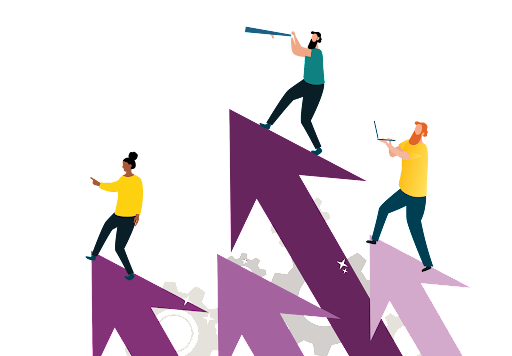
You may have heard the term “UX” before, but what does it actually mean, and why is it important?
What is user experience (UX)?
The International Organization for Standardization (ISO) defines user experience (UX) as “a person's perceptions and responses resulting from the use and/or anticipated use of a product, system or service”. Essentially, UX describes what the user is feeling before, while and after using a product or service.
One aspect to consider, however, is that UX is not static – it depends on a variety of factors, including:
- The product
- The usability, functionality and quality of the product
- How attractive and credible is the product itself?
- The user
- The user’s experiences, skills, expectations, personality, attitudes and needs
- What types of users is the product meant for?
- The context of use
- In what context does the user interact with the product? Is the user in a hurry? Is it for business or leisure?
- Is it a ticket kiosk you use at the train station during rush hour? Is it a coffee machine you use at home? Is it an app you use to get around the city?
- What is the general mood surrounding its use?
- The result
- How does the usage conclude? Successes and failures both leave a lasting impression.
With this in mind, how do we ensure good UX in our products and services? In other words, how do we create products that users actually like and want to use?
The answer is user-centered design. The user-centered design process is an iterative model that has four main stages:
- Understand the context of use.
- Define the user’s needs.
- Create solutions.
- Evaluate your solutions.
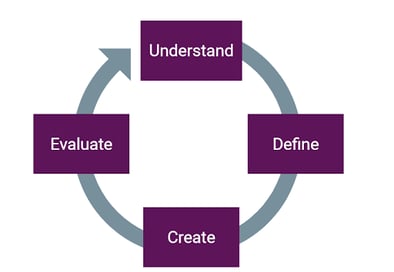
This version of the user-centered design model is simplified from the ISO 9241-210:2010 standard and describes an iterative process with four stages: understand, define, create and evaluate.
All four stages don't need to be completed every time, but the process generally follows this pattern. The cycle keeps going as long as it needs to, even indefinitely – in a world of continuous software development, it makes sense to refine the user experience continuously as well.
UX work in practice
How does this happen in practice? It’s good to start by investigating the user’s needs and desires by conducting workshops and focus group interviews. Depending on the situation, participants for these sessions can be recruited from one or several target demographics. The idea is to get a general overview of the needs and desires of the users in a casual environment.
Once we have gathered the data and insight we need to analyze and synthesize it in a way that helps us come up with concrete solutions. To represent our various user types, we can create so-called personas, which are realistic depictions of fictional people. Personas are useful because they help the team stay focused on a common goal: answering the user’s needs. Personas humanize the user and are much easier to remember than generic descriptions of user groups. Note that personas should always be based on real data and research – they are only valuable as long as they are realistic.
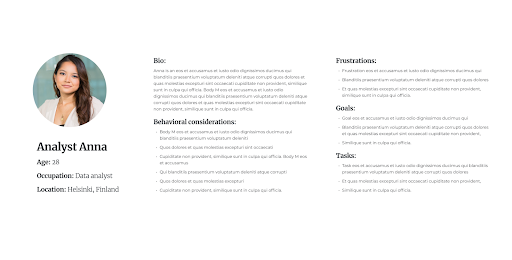
Personas describe a typical (but fictional) user of a product. They are typically assigned various characteristics, such as age, occupation, location, bio as well as behavioral considerations, frustrations, goals and tasks.
To visualize the user’s interaction with the product over time, we can use personas to craft journey maps that describe each step the user takes in a specific scenario. A scenario could look something like this:
Anna has a phone with a cracked screen and wants to purchase a new one. She wants something affordable but with a good camera since she likes taking pictures to show her friends and relatives.
In a journey map, we can describe each step Anna takes to achieve her goal in this scenario. Possible steps could include seeing an advertisement on the subway, searching for information online, reading reviews, choosing a model from a web shop, and going through checkout. Journey maps make important use cases tangible and understandable for the whole team. As with personas, however, journey maps need to be solidly grounded in data and user research for them to be useful.
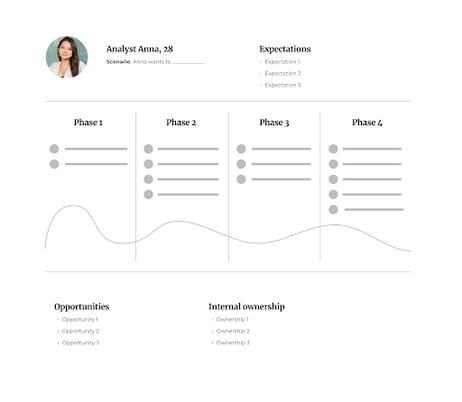
Journey maps describe the user's path through a specific scenario step by step.
All this insight and analysis is used to create solutions. A good way of turning insight into ideas is to conduct workshops. It’s best to involve people from different teams to ensure our solutions are realistic and feasible. Finally, we turn our ideas into a design. It doesn’t need to be fully functional at this point – a prototype can work just as well. Even low-tech manifestations, such as paper or cardboard prototypes can give great insight when put into the hands of users.
Now that we have something tangible, we can analyze the interaction between the user and the product in deeper ways. One way to do this is usability testing, where we observe real end-users operating our design in real time. Can they actually use it? What problems do they face? At this stage, we can also use other methods, such as interviews, questionnaires, analytics or A/B testing to complement the data gained in the usability testing. Based on our findings, we can further develop and update our personas and journey maps. From there, we create new solutions, evaluate them, and so on. The process continues as long as it needs to.
There is one thing to consider, however. While the user-centric perspective is great, it doesn’t have answers for everything. UX doesn’t take a stance on things like technical limitations or company strategy. Our designs need to be realistic – we can’t forget the tech and business side as they are vital for the success of our product. We need all three sides to work together. There are many ways to achieve this, but one way is to invite tech and business people to observe the UX research sessions as it helps keep everyone on the same page.
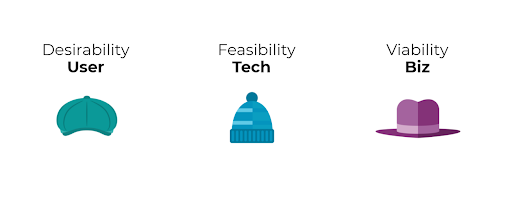
User-centered design is key, but the technology and business sides should also always be considered to ensure that solutions are realistic.
When deciding on solutions, one way to consider all three sides is to plot out ideas and solutions on a graph, where each solution is weighed against how easy (cheap) or difficult (expensive) it is to implement. This helps teams make informed decisions and prioritize in a smart way.
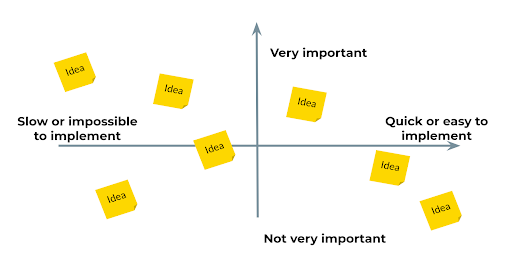
To make prioritization easier, solution ideas are often plotted on an XY graph, with the vertical Y axis representing the importance of the issue and the horizontal X axis representing how easy and quick the solution is to implement.
Why is UX important, and for whom?
Some of the key benefits of UX and user-centered methods are:
- Better products
A great product is one that matches the user’s needs. Constant iterative user testing throughout the life product life cycle ensures that the product feels great to use and solves the user’s problems in a smart way.
- Real savings
The iterative, fail-fast nature of user-centered design reduces the need for redesigns, fixes, maintenance, and documentation. Also, by having a product users understand and love using, you save on customer support and training costs. Good UX is good customer service!
- Perspective and insight
UX takes the guesswork out of building products and services by letting your process be guided by your users’ needs. Frequent user testing also means you have a constant “reality check” on your solutions and get a better sense of what really resonates with your users.
UX is also not just for designers and UX specialists. Other professionals can also benefit in a variety of ways.
How developers benefit from UX
Software development is like a ship in uncharted waters. To reach port, we can’t stay still – we have to move in some direction. Developing without UX is like sailing without a map or compass – by the time you realize you’re going the wrong way, it may already be too late. Developers who value UX gain the ability to adjust their sails according to the needs of the users. Each iteration of user research allows developers to reassess their course and not waste time on features that do not work. In other words, UX helps developers make better products more quickly.
If done right, UX can also be done in an Agile environment. Generally speaking, the UX and design work should be one step (at least 1–2 sprints) ahead of software implementation. This means that by the time a feature gets implemented, it has already been validated in terms of UX. This way, we can reap the benefits of UX even while being agile.
How consultants benefit from UX
UX can also be highly beneficial for consultants, especially those who consult software companies. With even a cursory understanding of UX, you can identify potential for user-centric methods in your clients’ work and learn to spot where they could improve their UX maturity.
User-centered methods can also help you understand your clients – you just have to think of your client’s employees as users. There is often friction between different teams and stakeholders within a company, since they don’t necessarily understand each other. Why not craft personas to represent different groups (e.g. Fredric Frontender, Margaret Manager etc.)? Why not conduct workshops where people from different departments ideate and come up with solutions together? UX methods are not just for understanding end-users – they can also help you break down barriers inside an organization.
How salespeople benefit from UX
UX offers a lot of possibilities for salespeople. On the consumer side, the better your user insight is, the easier it is to convince potential customers of the value of your products. On the business side, the better you understand the value of UX, the easier it is to sell user-centric design services as part of software solutions. You don’t need to become an expert in UX, but a general understanding is beneficial when talking to potential clients. This way you can spot opportunities for additional sales as they arise and help your customers make products that truly resonate with users.
Benefits for other professionals
Know that anything you make that human beings are supposed to interact with, UX probably has a tool or practice that can make your job easier. Since every situation is unique in some way, we encourage you to get acquainted with a UX professional who can help identify what tools or methods would help you the most. We in the Eficode UX Research and Design teams would love to lend you a hand – whether you’re making software, crafting marketing materials or writing important documents, we can help you make them even better.
Published:
Updated:

